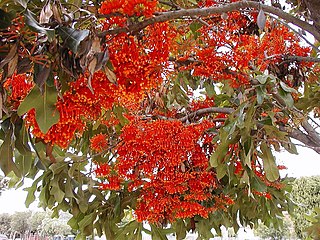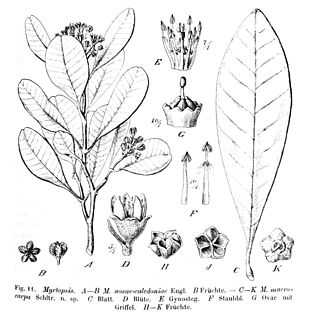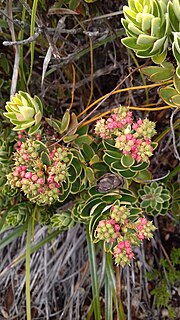
Montrouziera is a genus of shrubs to large trees in the family Clusiaceae, endemic to New Caledonia. As usual in the Clusiaceae, species of this genus are known to contain xanthonoids. Montrouziera is related to the South American genus Platonia. Locally known as "houp", this genus was named after Xavier Montrouzier.

Stenocarpus is a genus of about 25 species of woody trees or shrubs, constituting part of the plant family Proteaceae.

Apiopetalum is a genus of plant in the family Apiaceae, comprising 2 species. They are small trees, reaching 6 m in height, and have simple leaves. The genus is endemic to New Caledonia. Its closest relative is the Australian Actinotus.

Bikkia is a genus of flowering plants in the family Rubiaceae. It is native to the Philippines, the Maluku region of eastern Indonesia, New Guinea and the western Pacific. The genus was named by Caspar Reinwardt in 1825. Seven of the New Caledonian species previously included in Bikkia were transferred to a separate genus, Thiollierea, in 2011 based on molecular and morphological information.

Myodocarpus is a genus of plants in the family Myodocarpaceae. It is endemic to New Caledonia. The only other genus of the family is Delarbrea.
Solmsia is a genus containing one or two species of flowering plants belonging to the family Thymelaeaceae. It is endemic to New Caledonia. The genus was named to honor Hermann zu Solms-Laubach by Henri Ernest Baillon. It is related to Arnhemia, Deltaria, Gonystylus and Lethedon.
Oncotheca is a genus of tree endemic to New Caledonia. There are two species, Oncotheca balansae and Oncotheca humboldtiana.
Arthroclianthus is a genus of flowering plants in the legume family, Fabaceae. It belongs to the subfamily Faboideae. Its c. 19 species are all endemic to New Caledonia. Its closest relatives include Nephrodesmus, also endemic to New Caledonia, Ohwia and Hanslia.
Nephrodesmus is a genus of flowering plants in the legume family, Fabaceae. It belongs to the subfamily Faboideae. It contains c. 5 species, all endemic to New Caledonia. Its closest relatives is Arthroclianthus, also endemic to New Caledonia and their distinction has been challenged.
Dubouzetia is a genus of about eleven species known to science, growing from shrubs up to large trees, in Papuasia and Australasia and constituting part of the plant family Elaeocarpaceae.
Achlydosa glandulosa is a species of orchid endemic to New Caledonia and the only species of the genus Achlydosa. This species has previously been placed in the genus Megastylis. Its closest relative is Pterostylis, the sole other genus of subtribe Pterostylidinae.
Amphorogyne is a genus of hemiparasitic trees and shrubs in the family Santalaceae. The genus is endemic to New Caledonia in the Pacific and contains three species. Its closest relative is Daenikera, also endemic to New Caledonia.

Stromatopteris is a genus of fern in the family Gleicheniaceae, endemic to New Caledonia. The only species in the genus is Stromatopteris moniliformis. Its closest relative is the more widespread genus Gleichenia.
Salaciopsis is a genus of shrubs and small trees in the family Celastraceae. The genus is endemic to New Caledonia in the Pacific and contains six species.
Menepetalum is a genus of shrubs and small trees in the family Celastraceae. The genus is endemic to New Caledonia in the Pacific and contains four species. Its closest relative is Dinghoua from Australia.
Dicarpellum is a genus of shrubs and small trees in the family Celastraceae. The genus is endemic to New Caledonia in the Pacific and contains four species. Its closest relative is Hypsophila from Australia.

Myrtopsis is a genus of shrubs in the family Rutaceae. The genus is endemic to New Caledonia in the Pacific and contains c. 8 species.

Cyathopsis is a genus of shrubs in the family Ericaceae. The genus is endemic to New Caledonia in the Pacific and contains three species that have previously been included in Styphelia. It is related to genera such as Leucopogon, Lissanthe and Styphelia.
Gastrolepis is a genus of shrubs and trees in the family Stemonuraceae. The genus is endemic to New Caledonia in the Pacific and contains two species.
Flore de la Nouvelle-Calédonie is an ongoing multi-volume flora describing the vascular plants of New Caledonia in the South-West Pacific. published by the National Museum of Natural History in Paris since 1967. Each species treatment typically includes taxonomic information, morphological description, a line drawing and a distribution map. Originally published as Flore de la Nouvelle-Calédonie et Dépendances, since 2014 it has been renamed shortly Flore de la Nouvelle-Calédonie and is co-published with Institut de Recherche pour le Développement in a fully colored format. Flore de la Nouvelle-Calédonie currently consists of 27 volumes, covering little over 50% of a total of approximately 3,400 species native to the New Caledonian archipelago. Major botanical families awaiting treatment include Rubiaceae, Cyperaceae, Rutaceae, and Poaceae.








